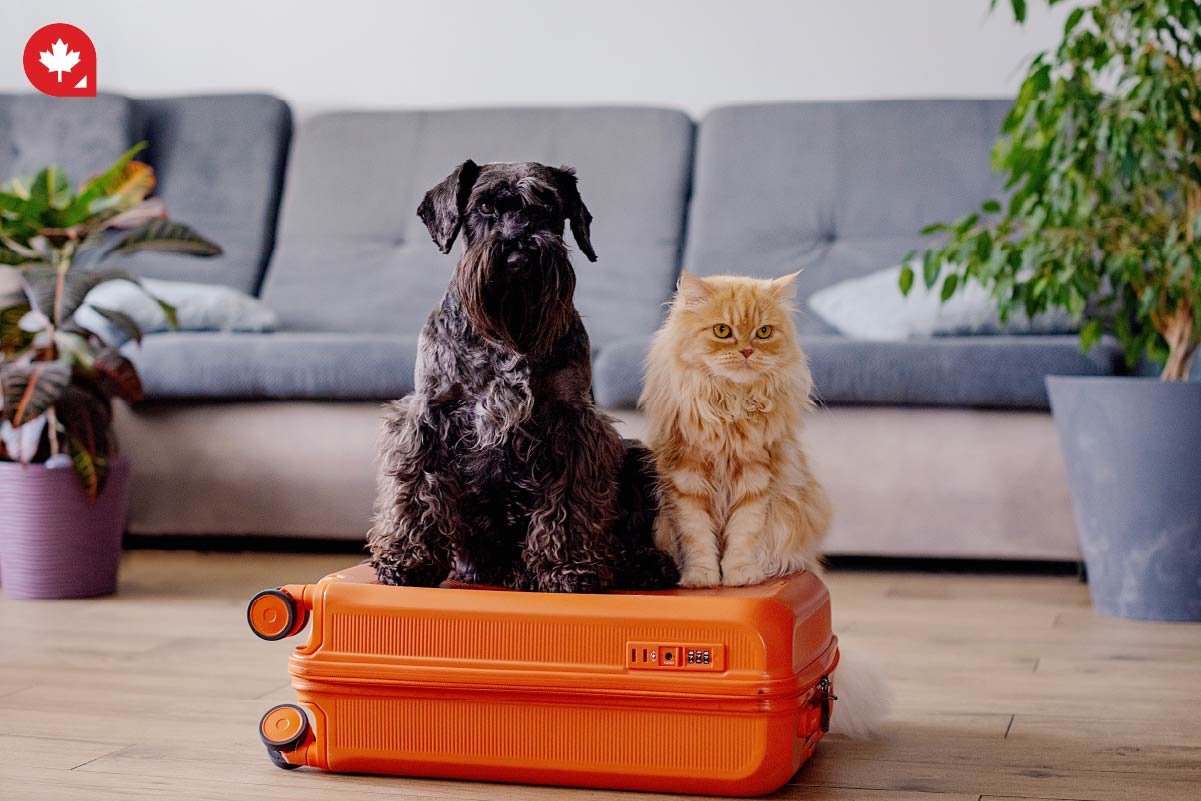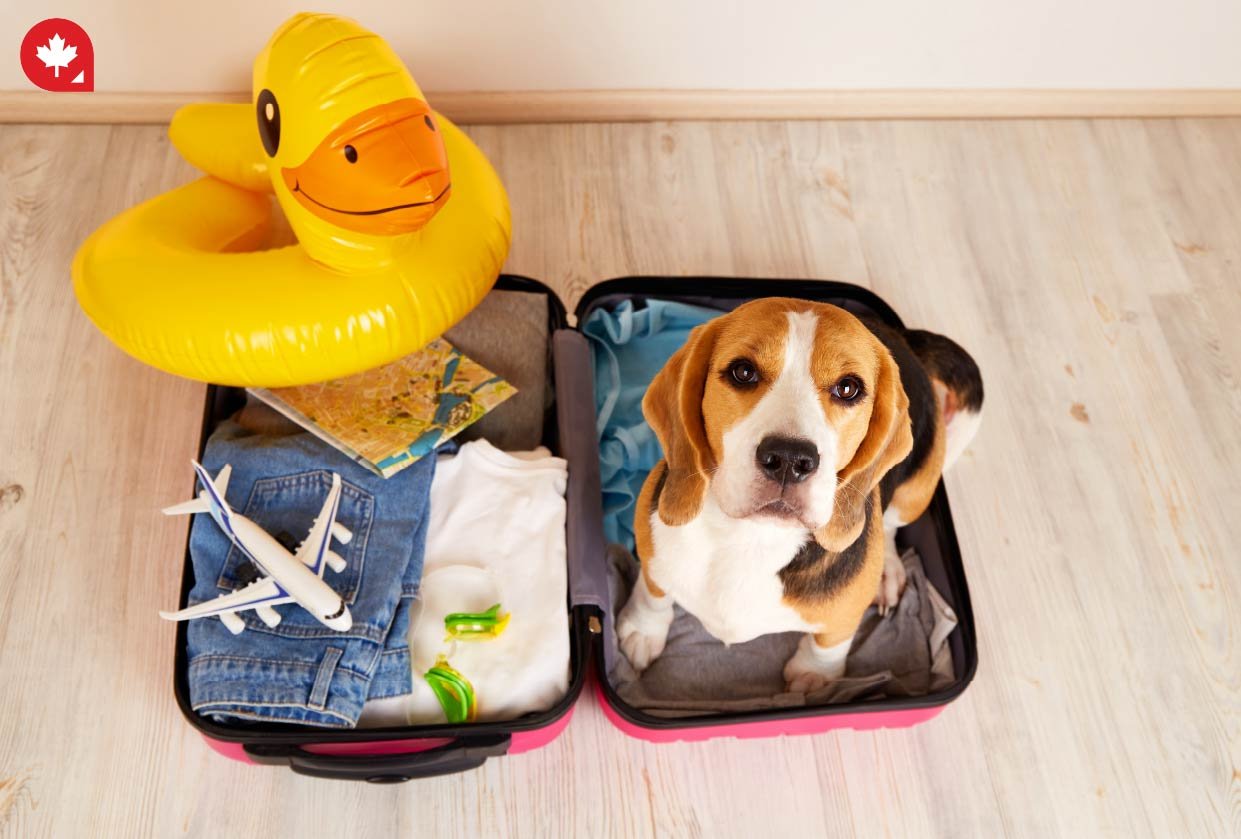Moving to Canada comes with many challenges, including packing up your current life and starting fresh in a new country. For those planning to make Canada their permanent home, a common question is whether they can bring their pets along.
Pets are often considered part of the family, with many owners treating them like children and celebrating their birthdays with parties and gifts. While the idea of moving with pets may seem straightforward, the logistics, especially when flying them to Canada, can feel overwhelming. Many people are unaware of the process or even that bringing pets, such as cats, from another country is allowed. To clear up any confusion: yes, you can move your pets to Canada.
Which Pets Can Be Brought to Canada You Immigrate?

In Canada, the Canadian Food Inspection Agency (CFIA) oversees the regulations for importing pets, livestock, and plants. We take a look at which pets may join you in Canada.
Cats and Dogs
Cats and dogs are among the most commonly imported pets and can be brought to Canada with relative ease. Dogs are only allowed to move to Canada from the age of eight months, and cats only from the age of three months old. Unfortunately, Canada does not compromise on its rules. They must have valid rabies vaccination certificates and, in some cases, additional health documentation, depending on their country of origin.
One of the most important things that you must be aware of is that dogs and cats must meet the minimum age limit if you are planning to enter Canada with them without import permits, but as a domestic import instead. This means that all pets must be accompanied by their owners to be able to enter the country.
Alternatively, you can also apply for an import permit from the CFIA if you would like to try and still get either a bird or non-traditional pet to Canada, but only if the pet qualifies under the commercial category. Before moving your pet to Canada, you must also know that you must present proof of your cat or dog’s age to the Canadian authorities to get the thumbs up for them to enter.
Additionally, if you thought that Canada accepted all types of dog breeds, think again. Canada does not accept the following dog breeds:
- American Staffordshire
- American Pit Bull Terrier
- Pit Bull Terrier
- Staffordshire Bull Terrier
What About Reptiles or Rodents?
Due to concerns related to the spread of salmonella, the CFIA does not allow the importation of amphibians or reptiles, including turtles and tortoises. On the other hand, most rodents, such as hamsters, guinea pigs, and rats, can be brought into Canada without requiring special certification, as the risk of diseases like bubonic plague is now minimal. This policy also extends to other rodents, such as capybaras, lemmings, and beavers.
Import Requirements For Pets in Canada
With Canadian immigration,, you must be prepared to meet the standards that Canada has set out for its residents, which means meeting the requirements for your pets.
Rabies Vaccination Certificate
Dogs and cats are not allowed to travel to Canada if they do not have a rabies vaccination certification that is written in either English or French. This is to prevent diseases from entering Canada. For this reason, the CFIA has established importation laws under the National Animal Health Program that applies to all animals that enter the country, whether it’s temporarily or permanently.
The certificate must also be signed and dated by a licensed veterinarian, state the color, weight, and breed of your pet, state that your pet is vaccinated against rabies, specify how long immunity against rabies will last, and indicate the relevant and licensed vet’s trade name and serial number.
Microchips
With the rabies vaccination requirement when moving to Canada, pets are also required to be microchipped, except for service dogs and pets that are younger than three months old.
According to a CFIA, a service dog is a dog that can provide a specific, trained service to people who are otherwise limited in their abilities to perform specific tasks. Service dogs do not have to meet import requirements if they are accompanied by someone that they aid when they arrive in Canada. However, they must have official documents that state that they are service animals.
Puppies and kittens are the second exemption for import requirements. They are not old enough to receive rabies vaccinations and as a result, do not require a rabies certification to get to Canada. In this case, you must provide proof of the age of your pet upon request.
Inspection Process and Fees
At the Port of Entry (POE), Canada Border Services Agency (CBSA) officers are stationed to check whether the rabies certificate for all of your pets has been issued recently. They will also check whether the pet description matches that of your pet, as well as if your pets show signs of illnesses. If your pet passes all of the requirements, they will gain entry.
The fees involved include around 30 CAD + tax for the first pet, and around 5 CAD + tax for each additional pet. Be sure to confirm these fees on official Canadian sites.
Should your pet not meet the requirements, you will be granted two weeks after arriving in Canada to get them vaccinated, upon which you must then return the paperwork to the CFIA. Apart from paying for the vaccination, you must pay a higher entry fee of around 55 CAD + tax for the first pet, and around 30 CAD + tax for every additional pet.
Note that if your pet shows any signs of being ill, a border agent can contact the CFIA for another inspection, of which additional fees.
Steps to Bringing Your Pets to Canada

Moving to Canada with your pets can be an exciting yet complex process. To ensure a smooth transition for both you and your furry friends, it’s essential to follow these important steps.
Step 1: Research and Prepare Ahead of Time
Bringing pets to Canada requires thorough preparation to meet national import regulations, which the CFIA manages to ensure animal and public health. Always review the most recent guidelines on the CFIA website. Pets, especially cats and dogs, typically need an up-to-date rabies vaccination certificate accompanied by veterinary documentation. Microchipping is highly advisable for easier identification, and having a pet passport with vaccination and health records can simplify the process.
Step 2: Gather Documentation Essentials
Collecting the necessary paperwork is key to avoiding delays or issues at customs. Essential documents include a valid rabies vaccination certificate that details your pet’s information such as name, breed, age, and vaccination dates. Additionally, a veterinary health certificate from a licensed vet is often required to confirm your pet is healthy and fit for travel. This document might need to be prepared within a specific period before your move.
Step 3 Choose a Mode of Transportation
Deciding how to transport your pet depends on your preferences, budget, and your pet’s comfort. Most international pet travel is done by air, so it's vital to select an airline known for excellent animal care and become familiar with its pet travel policies, including approved carriers. If you are relocating from the U.S., driving can be an option, but make sure you have the necessary border documents and prioritize your pet’s comfort by planning regular breaks for food, water, and rest.
Step 4: Preparing Your Pet for Travel
Long-distance travel can be challenging for pets, so taking steps to reduce their stress is essential. Start by getting them used to their carrier by leaving it open at home for weeks before the move and encouraging them to explore it. Practice taking short trips in the car to acclimate them to movement. Finally, pack items like their favorite toys, a familiar blanket, and travel-friendly bowls to provide comfort and familiarity during the journey.
Your Pet’s Arrival in Canada

Upon arrival, your pet may be inspected by a border agent to confirm that all documentation meets Canadian regulations. Some pets may be subject to an additional health examination. If everything is in order, the process is usually quick.
Tips for a Smooth Transition
Once your pet has arrived, helping them adjust to their new home and surroundings is vital. Here are some tips for doing this.
- Explore Gradually: Let your pet explore their new home at their own pace.
- Routine and Comfort: Maintain familiar routines to provide comfort and security. This includes regular feeding times and walks.
- Vet Checkup: Schedule an appointment with a local veterinarian soon after arrival for a wellness check and to discuss any specific regional concerns (e.g., ticks, wildlife).
FAQs
Will My Pet Have to Quarantine Once it Gets to Canada?
Canada generally does not impose quarantine for pets, provided they meet all health and vaccination requirements.
Are There Any Special Conditions For Brings Certain Pets?
If you are bringing exotic pets (e.g., certain bird species or reptiles), consult specific regulations as they might require permits or have restrictions.



